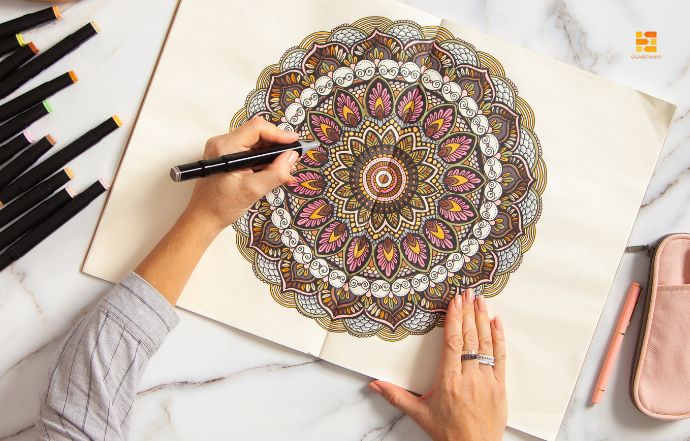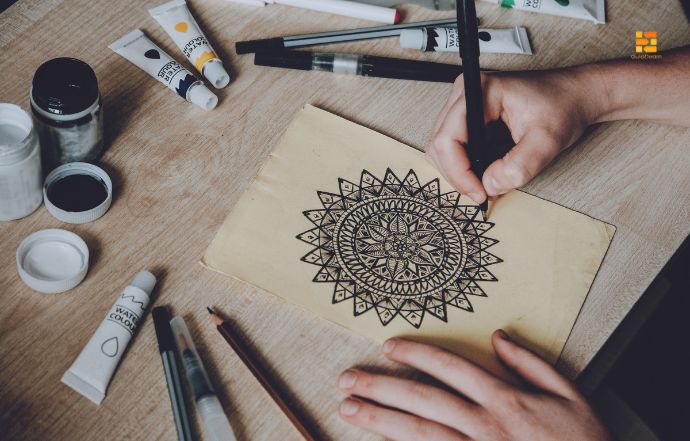Mandalas, the captivating circular designs, have a way of transporting us. The key to creating stunning mandalas might surprise you: it's all about the paper. Yes, that humble sheet you take for granted can become your secret weapon, transforming your mandala from a simple sketch into a captivating masterpiece. It can impact the vibrancy of your colors, the detail of your lines, and the overall feel of your finished piece.

Contemporary Mandala
This guide will equip you with the knowledge to find the perfect paper for your mandala artwork!
Finding Your Ideal Weight: Demystifying Paper Thickness
Paper weight, measured in grams per square meter (GSM), determines how thick and sturdy the paper is. Here's a breakdown to help you choose the weight that best suits your mandala-making needs:
| Type of Paper & GSM | Ideal for |
|---|---|
| Lightweight Papers (80-120 GSM) | Practicing color combinations, testing techniques, or creating smaller mandalas. Heavier mediums might bleed through, so stick to pencils, crayons, or light pressure with other mediums. |
| Mediumweight Papers (130-180 GSM) | A good balance between affordability and handling a wider range of mediums like markers, pens, colored pencils, and light washes of watercolor. |
| Heavyweight Papers (190+ GSM) | Detailed work and heavier mediums like acrylic paints, inks, and even mixed media. Their luxurious feel enhances the creation process and allows for multiple washes and layering without warping. |

Floral Mandala
Pro Tip: Explore "hot pressed" and "cold pressed" textures within your chosen weight
A World of Paper Options: Unleashing Artistic Potential
| Type of Paper | Description | Best For |
|---|---|---|
| Drawing Paper | Available in various weights and textures. | Detailed mandalas with colored pencils, markers, and pens (smooth surfaces) or charcoal and chalk pastels (slightly textured surfaces). |
| Watercolor Paper | Acid-free paper with a high cotton content (ideally 100%) for better color vibrancy and longevity. | Creating mandalas with washes of color. Choose cold-pressed textures for beautiful watercolor effects. |
| Mixed Media Paper | Your best friend for all types | Versatile paper that handles a variety of mediums, including paints, inks, markers, and even collage materials. |
| Bristol Board | Offers a smooth, hard surface. | Creating mandalas with technical pens, fineliners, or even intricate ink washes. |
| Canvas Mandalas: | Stretched canvas for a unique and textured piece. | Using acrylic paints, markers, or even mixed media to create truly unique mandalas. |
Here are some things to keep in mind when selecting your mandala paper:
- 1. Match Your Medium:
- Ensure the paper weight and type can handle the mediums you plan to use.
- 2. Size Matters:
- Heavier papers are ideal for larger mandalas with detailed work.
- 3. Finding Your Texture:
- Experiment with different textures to find one that complements your artistic style.
- 4. Budget Considerations:
- Choose paper that's cost-effective based on your needs.
Bonus Tip: Sample packs and artist-grade sketchbooks often offer a variety of paper types and weights. This allows you to experiment and discover your perfect match before committing to larger sheets.
Choosing the right paper is a personal journey. Exploring different options, experimenting with various mediums, and discovering the paper that elevates your mandala creations and sparks your artistic expression is a learning journey. For anyone who is willing to learn they can do so by enrolling for a free demo online class for Mandala with GuidElearn.